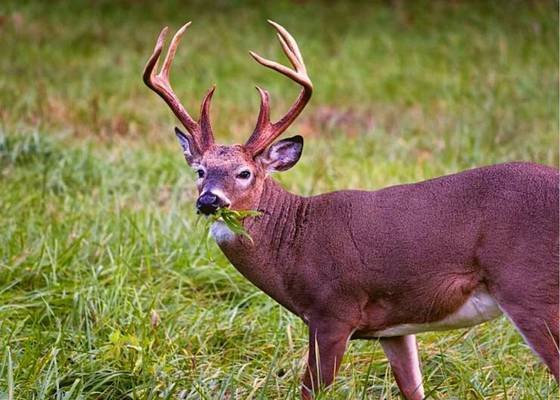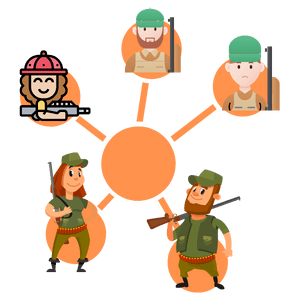Some hunters spend the entire day in the field, from well before sunrise until after sunset, whilst others will head out for a few “prime time” hours.
There is no hard and fast rule as to when is the best time of day to hunt deer.
Although some time periods will be more productive in different areas, at different times of the deer hunting season.
In this article we will look at:
Why Does Time of Day Matter?

Deer are crepuscular animals, meaning that they feed or are most active during twilight hours.
It is well known that dawn and dusk are key deer movement periods, given that their primary feeding time is throughout these periods, and therefore they also move between feeding and bedding locations during these hours.
However, that does not mean that outside of these twilight hours that deer cease to exist, or disappear completely.
Throughout the day deer are primarily bedded down, but will still move around from time to time; and even more-so during the phases of the rut.
Time of day matters because it will likely affect your hunting style, and set up location at different periods of the day, if you wish to improve your odds of deer crossing your path.
When Do Deer Come Out During The Day?
Morning

The early morning hours are the time when deer are finishing up their evening feeding, still moving around, but slowly working their way from being in the fields and heading back into bed.
During this time many hunters will hike into their prime hunting locations in the dark, well before shooting hours in order to allow the area to settle back down after their presence.
And let the deer continue to move around them.
Where To Hunt Deer In The Morning?
Hunting the edges of feeding areas and key travel paths between open feed areas and timbered bedding areas can be fruitful in these early hours of the day.
It is worth noting that it is common to find a bunch of deer in one area.
So being aware and taking your time is important so that you do not bump an unseen deer, therefore alerting and bumping the whole group.
Example morning time frame:
Deer may feed and move through open and visible areas from well before sunrise, until around 10:00am; before looking to bed down.
Midday

Just because deer have ventured into their bedding areas later in the morning, that does not mean that quality hunting opportunities stop.
During these hours you can still find rogue bucks on the move.
Some whitetails that are slow in working their way back to bedding, or that after a couple hours of laying down late morning, want to get up and wander around a little bit.
Where To Find Deer In Midday?
Deer are unlikely to be venturing out into the open feeding areas, but there are some key areas where you have a reasonable chance of spotting deer.
Although they will continue to stay in or close to the timbered areas, if you can find travel corridors that connect timbered areas, with a smaller channel or funnel point, deer will likely use that path to travel between areas, so as to not expose themselves in wider areas.
Even more
You may also find smaller feed pockets surrounded by timber where deer go for a small quick midday bite of food.
Little bowls of opening with forest bending around it gives the deer the perception of being less exposed during these day hours.
Example midday time frame:
From 10:00am deer are usually back in the forest.
At times there will be basic localized movement to relocate their bed, stretch their legs, or have a little food or water.
They will generally stay around cover until around 4:00pm.
Evening

Via Realtree
Once the evening starts to come and the light gets a little lower, deer will slowly venture out from their bedding areas to feed. These are good times to find them wandering out into the field.
These can be especially productive times as it gives the hunter time to get into a good location during daylight hours, knowing that you have the ability to watch the area, and hopefully not accidentally bumping deer on the way in.
Where To Hunt Deer In The Evening?
Edgelines of feeding areas and edgelines between timber and fields can be good set up points during these hours.
Example evening time frame:
After 4:00pm (or approximately an hour before sunset) deer will start to venture towards more open areas, ready for twilight and evening feeding periods.
They tend to stay out into the evening, beyond legal shooting hours.
Daytime Behavior Changes During Season:
Even though deer behavior is generally pretty consistent, there are times of the year in which deer patterns change.
It is primarily affected by the deer breeding season, known as the “rut”. Let me explain:
Pre-Rut

Prior to the rut, in the “pre-rut” period, usually around late October, bucks will start to spend more of their day time roaming around looking for does.
Although they are on the move a little more, they are still not likely to venture too far into the open, and will put in their work in the timbered areas, moving around near to doe bedding areas.
It gets better:
Bucks are likely to be traveling downwind of potential doe bedding areas.
So if you plan to hunt through the middle of the day, be sure to get in behind these areas, still hunting or setting up from behind, further downwind of the potential buck travel routes.
Hunting feeding zones are still likely to be beneficial in the early, sunrise time of day, before moving further towards the timber from around 9am onwards.
Mid-Rut

Via Realtree
During the rut deer is the peak deer movement time. Whilst twilight activity may stay largely consistent, you may find a little more chaos and movement across the board.
This increased movement makes it more likely that you will see deer moving through different areas, and sometimes in larger groups.
Feeding periods may continue to take place in the open, where the primary food sources are.
Through middle-of-the-day time periods deer are still likely to stay near-ish to cover, but may be a little less stringent about staying in the timbers.
Edge habitat and small openings between larger areas of cover are great for seeing them during this time.
Post-Rut

After the rutting period, deer tend to settle back down a little bit again. Bucks and does go back to normal routines.
That said, this is when the cold weather starts to come in.
So paying attention to changes in the weather may help you to determine which times of each day you could expect potential changes in behavior, and therefore use it to your advantage (more on that later).
Where Do Deer Go During The Day?
Deer are generally found in two primary locations: feeding areas and bedding areas, moving in between both.
Bedding areas and cover are usually in thicker woods or timbered areas, whilst the best feeding opportunities for deer tend to be more in the open; such as natural fields or agricultural food plots.
But wait, there’s more…
Food Plots or Fields

Deer are browsers, meaning that they eat leaves, bark and stems from plants.
For most of these food sources sunlight, water and fresh growth is required, usually meaning that they are most prevalent in open areas.
In natural wilderness areas openings that break up areas of heavy timber are a good starting point for looking for deer feed areas.
In more built up urban areas, deer are often found roaming near to agricultural regions and can be found feeding on crops.
Due to the nature of these areas being open, they provide better deer sighting opportunities for hunters, and therefore decent shooting opportunities.
Timbered Bedding Areas

Via osgnetworks.tv
Deer spend the majority of the middle of the day under thick cover. As with most species, they need the ability to rest, but at the same time ensure they are safe.
Thick timbered areas give them the opportunity to remain hidden from the sight of predatory animals and people.
During this time deer will still continue to have semi-heightened senses, so being aware of the wind direction during these times is important, as to not alert deer in the area.
Noise, crunching leaves and sticks are something to also consider. It may not instantly spook deer, as the woods and animals do make sound, but still important to be aware of.
Think about it...
Setting up near bedding areas or mid-forest game trails is a good place to spend those midday hours.
As you have a better chance of seeing them during these times in covered areas than in exposed fields.
What Factors Impact Deer Movement?
Although deer are quite consistent, and semi-predictable in their patterns, there are still different impeding factors that may disturb their schedule of behavior.
Let me tell you...
Weather

Varying weather conditions are one of the key factors affecting regular deer movement and activities.
Whilst light winds, snow and rain may not change deer patterns too much.
Higher winds and heavier rain usually result in deer bedding down deeper, for longer, in order to protect themselves from the weather and the impact it has on their defensive mechanisms, their senses.
It has also been shown that deer move during periods of increasing barometric pressure, or when the temperature is about to plummet.
Deer, along with many other wild animals, have an ability to sense incoming changes in weather, and therefore use this window of opportunity ahead of time to move around and to load up on food and water.
Hunting Pressure

It may be an obvious one, but the pressure from hunters and human activity in general will have an impact on an area that holds (or usually holds) deer.
Why's it so important?
Like any other animal, self-preservation and survival is the primary objective for deer.
So when a threat is detected they will do what they can to avoid it, and that may mean stopping their feed cycle and leaving the area.
When hunting it is important to reduce risk of bumping deer; by being stealthy, managing your location against the wind direction and being patient.
Predator Pressure

Pressure from predatory animals (such as bears, wolves, mountain lions and coyotes) also affects deer movement and patterns.
Areas with predators may break up a deer’s daily schedule or force them to leave an area completely.
Being aware of predatory animals and tracks in the area might help you to determine whether the deer are on high alert, more skittish and affected more so than they may usually be.
In My Experience:

In my time whitetail hunting I have come across deer at all times of the day: seeing deer on our way to location well before daylight, through early shooting hours, into lunch time and through to late evening.
In terms of total deer seen, the early light hours (within 2 hours after sunrise) and late evening (an hour before sunset) seem to provide the goods.
However some of the better shooting opportunities have come through the late morning and lunchtime periods (having had twice gotten deer closer to 11am), when deer are more casually roaming alongside the timbers edge, on less alert than when they are out in the open feeding.
Bottom Line:
It would be nice if there was a specific window of time primed for deer hunting, where your chances of success are infinitely greater, but that is unfortunately not the case.
Every day, throughout the day offers different opportunities at different times, and the time that deer come out depends on a variety of factors.
Deer behavior, movement and overall activity will vary throughout the season, and throughout each day.
A hunter has the ability to get a deer at all times of legal shooting hours.
However the likelihood of success will depend largely on whether you are able to get set up wherever the deer are, at different times during the day.
In your opinion, what is the best time of day to hunt deer? We would love to hear from you in the comments!
